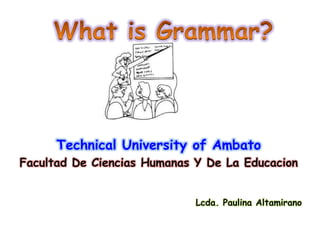
Tarea 6 spac
- 1. Technical University of Ambato Facultad De Ciencias Humanas Y De La Educacion Lcda. Paulina Altamirano
- 2. What´s * Study forms or structures in a Grammar language. * Study the SYNTAX and MORPHOLOGY of sentences. Text, sentenc SYNTAX es, words, so System of rules that cover the order of words. unds. MORPHOLOGY System of rules that cover Four levels of the information of words. languages. They are the We will assume FORMS that grammar to mean at languages takes. the level of the sentence.
- 3. GRAMMAR MEANING *One feature is Meaning-making * Is conveyed simply at the potential. LEXICAL. (The language * Communicates meanings. doesn t work very hard). (Vocabulary communicates *Variety of meanings - meaning). depending on their vocabulary *The more contex the less and knowledge. grammar. Ex: Tickets! . Seen from this perspective, grammar is a tool for making meaning.
- 4. REPRESENTATIONAL INTERPERSONAL The way we TWO The way we perceive the interact with KINDS OF world. other MEANING people, we use grammar.
- 5. GRAMMAR AND SPOKEN GRAMMAR FUNCTION AND WRITTEN GRAMMAR SPOKEN.- omits words, uses tag questions, sentence s with two subjects. (Informal) WRITTEN.- use more syntactically complex constructions. (Formal)
- 6. GRAMMAR SYLLABUSES TWO SETS OF DECITIONS SELECTION GRADING Learnability.- Complexity.- the more the more simple the Usefulness Frequency elements the more more complex learnable. It is not the case that Teachability.- easy to the most frequently demonstrate occurring items are the the meaning most useful.
- 7. GRAMMAR RULES PRESCRIPTIVE: grammar instructions is associate with teaching what should be said or written – we have to follow. DESCRIPTIVE: rules about what speakers of the language actually do say rather than with what they should do ( more useful what is necessary to say) PEDAGOGIC: make sense to learners. Rules of Form.- generally easier to formulate. “follow a pattern” – “a model” Rules of Use.- are less easily accommodated into a general rule. (depend on specific situations)
- 8. GRAMMAR RULES PRESCRIPTIVE: grammar instructions is associate with teaching what should be said or written – we have to follow. Use the present perfect to talk about activities that started in the past and continues until now. Add “ed” after most verbs to form the past tense of some verbs
- 9. GRAMMAR RULES DESCRIPTIVE: rules about what speakers of the language actually do say rather than with what they should do ( more useful what is necessary to say) You should put the adverbs of frequency after MOST VERBS We need to start a new idea using capital letters.
- 10. GRAMMAR RULES PEDAGOGIC: make sense to learners. Rules of Form.- generally easier to formulate. “follow a pattern” – “a model” Rules of Use.- are less easily accommodated into a general rule. (depend on specific situations) Present continuous Are you living at home now? Is she still working in New York? Who are they visiting their weekend? What’s the matter? What’s this for?
- 11. Grammar Grammar rules description of Grammar adds they convince the the rules for meanings no imput ant the forming inferable from output in order sentences the immediate to communicate. context. Representational Complexity (activities (perceive) easy- difficult) Learnability (every CONCLUSIONS Interpersonal (socialize) body learn in a different way) Form and Meaning could be different Teachability meanings if we Written form of the (techniques, meth don't have a language (traditional) ods) context. Spoken language has its own distinctive grammar.